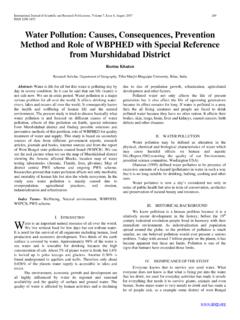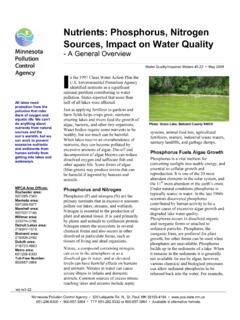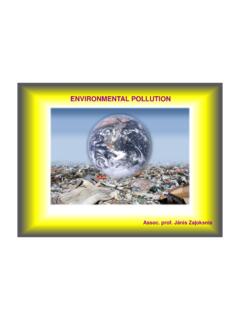Transcription of Lesson 1: Aquatic Ecosystems - USF
1 1 NEIGHBORHOOD WATER QUALITY. Lesson 1: Aquatic Ecosystems Keywords: ecosystem, ecology, watershed, surface water, hydrologic cycle, evaporation, transpiration, precipitation, surface runoff, percolation, porous, aquifer, groundwater, spring, pond, phytoplankton, zooplankton, photosynthesis, An ecosystem is a natural unit of biological components. The plants living and nonliving parts that interact within an ecosystem convert the to produce a stable system. Ecology sun's energy into food, and are in is the study of Ecosystems , or how turn grazed upon by animals, which living things relate to the are consumed by predators.
2 Environment and to one another. Microorganisms within an Understanding this relationship is ecosystem, such as fungi and important because living things and bacteria, also exchange energy non-living things depend upon and within the ecosystem by breaking impact each other. down waste material to substances that can be used by plants for food. Ecosystems operate from day to day In this way, each element within the by exchanging energy. The energy ecosystem depends on the others for exchanged within an ecosystem is survival. recycled between the physical and Aquatic Ecosystems and Watersheds Aquatic Ecosystems include oceans, which water flows to reach a lakes, rivers, streams, estuaries, and common body of water such as a wetlands.
3 Within these Aquatic lake or pond. We all live in a Ecosystems are living things that watershed, or drainage basin. depend on the water for survival, Watersheds can be as large as the such as fish, plants, and Mississippi River drainage basin or microorganisms. These Ecosystems as small as a farm with a pond. Your are very fragile and can be easily watershed may be made up of disturbed by pollution . mountains, farms, houses, businesses, or towns. You share All living things within an ecosystem your watershed with all other living share the same watershed.
4 A things within the ecosystem. watershed is an area of land over PROJECT OCEANOGRAPHY 1 NEIGHBORHOOD WATER QUALITY. FALL 2000. NEIGHBORHOOD WATER QUALITY. A watershed is a good example of directly into the water. This will have how the living and nonliving things an effect on the organisms that within an ecosystem depend upon depend on the water for survival. For each other. Altering a watershed will example, some fish feed on affect all the living things within that organisms in the water. Polluted watershed. People can alter a water may cause these organisms to watershed by paving over land and die, leaving the fish with no food.
5 Constructing buildings. This will affect This is why we must understand how water flows over the land and these relationships and protect our may cause harmful materials to flow water resources. Today's Water Only 1 percent of the water on Earth glaciers, within the ground as fresh is available to humans as fresh groundwater, fresh surface water, water. Most of the earth's water and in the atmosphere. Fresh exists in the oceans as salt water. surface water includes water in The small percentage of water lakes, rivers, streams, creeks, remaining on the earth's surface is ponds, and found trapped in polar ice caps and PROJECT OCEANOGRAPHY 2 NEIGHBORHOOD WATER QUALITY.
6 FALL 2000. NEIGHBORHOOD WATER QUALITY. wetlands. Humans obtain their fresh This is why we must protect our water from surface waters and fresh water supplies. groundwater. These make up only a small quantity of the world's water. The Hydrologic Cycle The hydrologic cycle is the the surface as ground water. The circulation of water among the water may exist as each of the three oceans, the atmosphere, and the states of matter: solid, liquid, or gas. land masses, through evaporation, Evaporation is the change in water precipitation, surface runoff, and from a liquid to a gas.
7 Water groundwater percolation. The cycle evaporates from the surface of the has no beginning and no end. This oceans, lakes, streams, and rivers. means there is no new water put into As the sun heats the surface waters, the cycle, the same water is used water will be released into the over and over again. Water exists in atmosphere in the form of water all stages of the cycle: oceans, vapor. The greater the sun's energy, clouds, lakes and rivers, and below the more evaporation occurs. The PROJECT OCEANOGRAPHY 3 NEIGHBORHOOD WATER QUALITY. FALL 2000.
8 NEIGHBORHOOD WATER QUALITY. sun can also cause water to Plants and animals will use some of evaporate from plants leaves the precipitation that falls over land, through a process called and some of the precipitation will be transpiration. absorbed by the ground and moves Water vapor rises from the surface downward through the soil in a waters and enters the atmosphere process called percolation. Once where it is transported by winds. the surface water has moved When atmospheric conditions are underground it is called suitable, water droplets will form and groundwater.
9 Stick together to form clouds. This process is called condensation. The water that enters these When the atmosphere is saturated, pathways eventually finds its way or cannot hold anymore water vapor, back to the oceans through river these droplets will be released and runoff, groundwater flow, and melting fall to the earth's surface as ice, which all discharge water into precipitation. the oceans. This closes the hydrologic cycle by returning the Precipitation is water that is water originally removed from the released from the atmosphere as ocean by evaporation.
10 Rain, snow, hail, etc. Precipitation that falls to the Earth's surface can In this way, water goes around the enter several different pathways hydrologic cycle. No new water is put within the hydrologic cycle. on Earth; it is just stored in different Precipitation that falls over bodies of places on Earth in different states water such as lakes and rivers (solid, liquid, and gas). This means becomes surface water, that we have the same amount of Precipitation that drains across the water on earth today as when the land and into lakes, streams, and dinosaurs roamed the planet.







